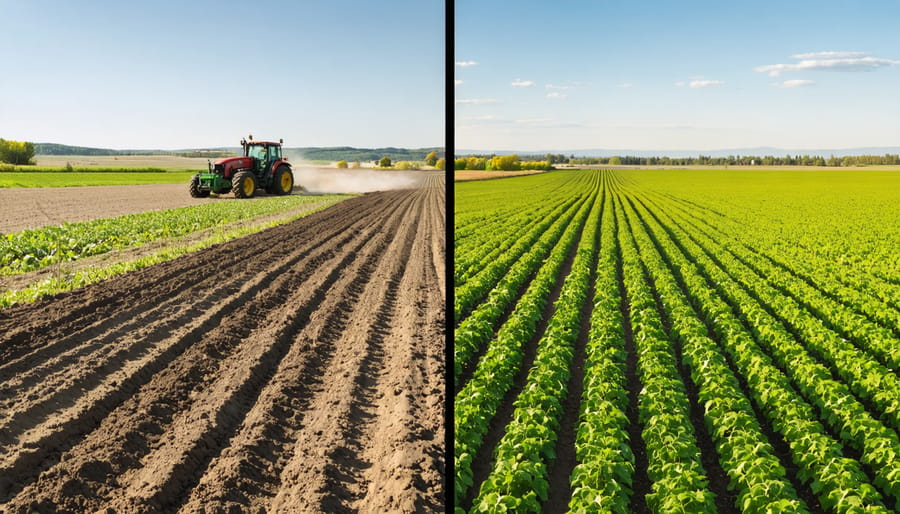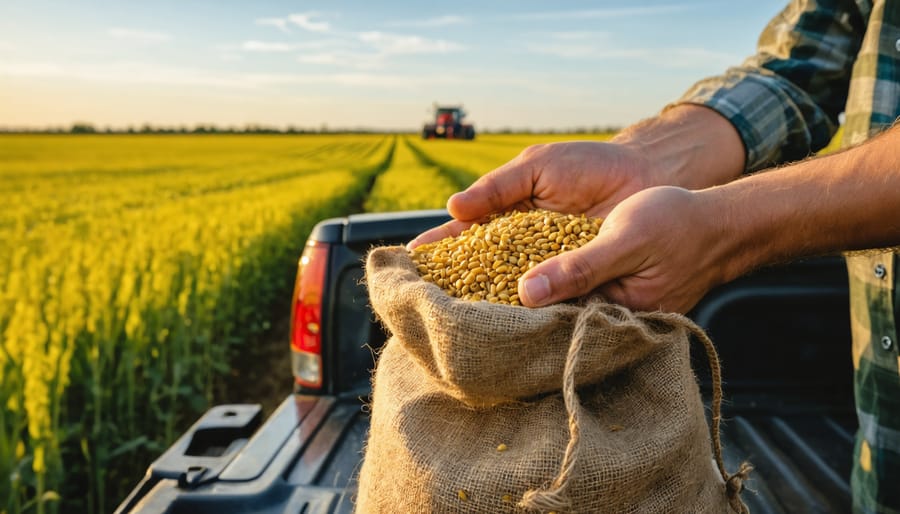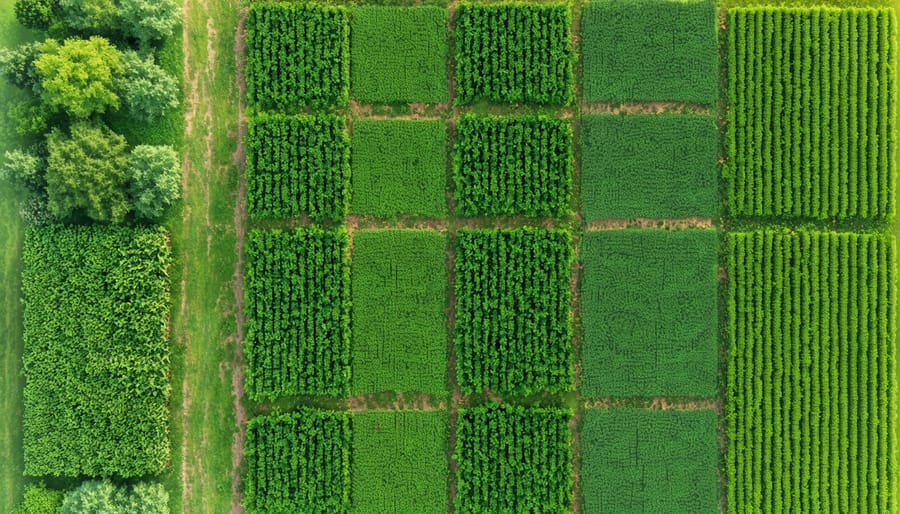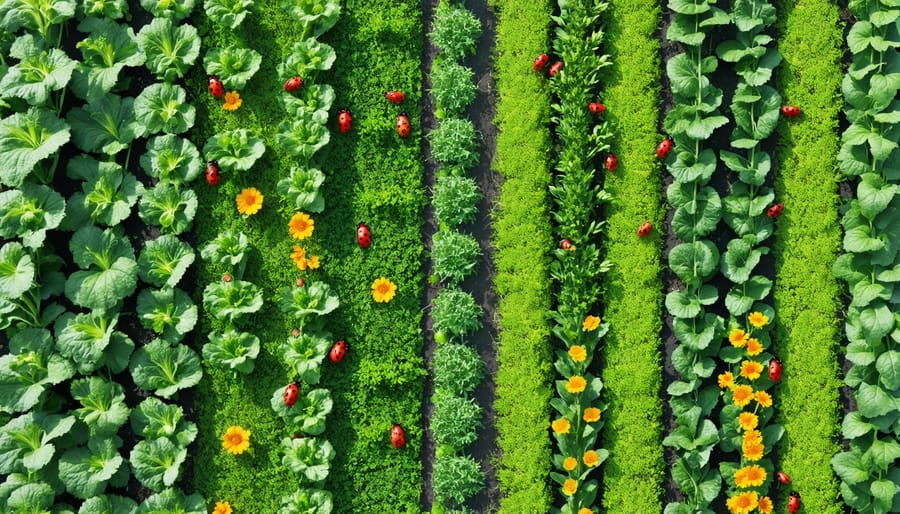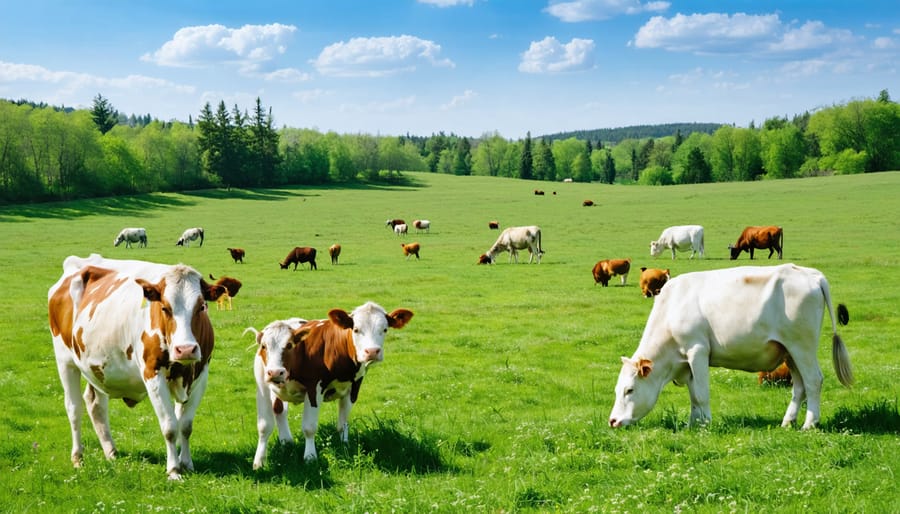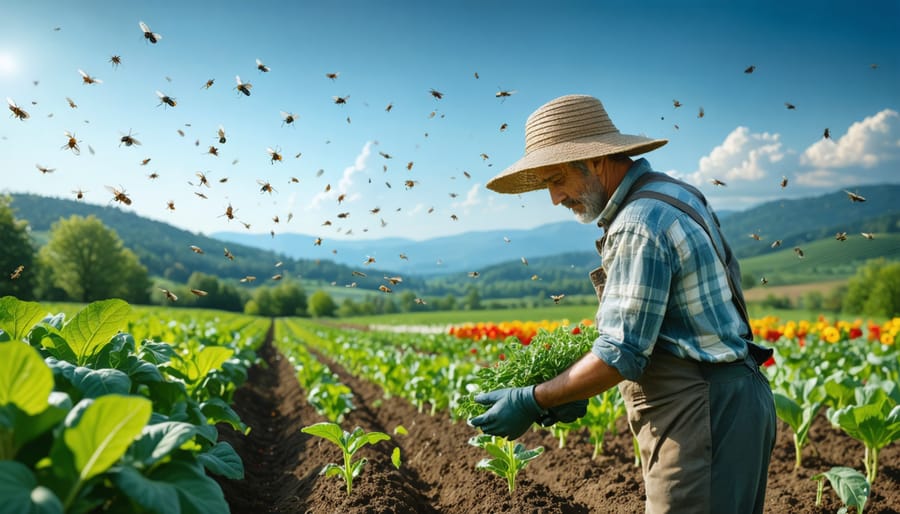The debate around organic farming’s environmental impact extends far beyond simple “good versus bad” arguments. As Alberta’s farmers navigate increasing pressure to adopt sustainable practices, emerging research challenges the long-held belief that organic certification automatically equals environmental stewardship. While organic methods eliminate synthetic pesticides and reduce chemical runoff, they often require more land to produce equivalent yields – sometimes up to 25% more than conventional farming. This reality creates a complex trade-off between local chemical reduction and broader land-use implications.
For Canadian producers, particularly those managing the unique challenges of Prairie agriculture, the environmental equation becomes even more nuanced. Recent studies from the University of Alberta show that organic practices can increase soil organic matter by 8-15% over conventional methods, yet may contribute to higher greenhouse gas emissions through increased tillage and cover crop management. Understanding these trade-offs is crucial as our agricultural sector works to balance food production with environmental stewardship.
This analysis explores how organic certification requirements affect both farm-level ecosystems and broader environmental impacts, offering practical insights for producers weighing their certification options. By examining real-world data from Canadian farms, we’ll uncover how local conditions, farming practices, and market demands intersect to influence the true environmental footprint of organic agriculture.
Organic Certification Standards and Environmental Trade-offs
Canadian Organic Regime Requirements
In Canada, farmers must adhere to strict organic certification standards established by the Canadian Organic Regime (COR). These requirements focus on maintaining soil health, protecting biodiversity, and promoting sustainable farming practices. Farmers must follow a three-year transition period during which they eliminate synthetic pesticides and fertilizers from their operations.
Key requirements include maintaining detailed records of all farming practices, using only approved substances listed in the Permitted Substances Lists (PSL), implementing crop rotation plans, and establishing buffer zones between organic and conventional fields. For Alberta farmers, these standards also emphasize water conservation and soil erosion prevention, particularly important in our prairie climate.
The certification process involves annual inspections by accredited certification bodies, ensuring compliance with all regulations. While these requirements may seem demanding, they’re designed to protect both the environment and consumer confidence in organic products. Many Alberta farmers report that following these standards has actually improved their soil quality and reduced their overall environmental impact over time.
Compliance Challenges for Alberta Farmers
Alberta’s organic farmers face unique environmental challenges in Alberta when striving to meet organic certification standards. The province’s short growing season, varying soil conditions, and extreme weather patterns create significant hurdles for compliance. Many farmers report struggling with weed management without conventional herbicides, particularly during wet seasons when mechanical cultivation becomes difficult.
Documentation requirements pose another substantial challenge, with farmers needing to maintain detailed records of all farming practices, inputs, and crop rotations. This administrative burden can be especially demanding for smaller operations with limited staff. The three-year transition period required for organic certification also presents financial strain, as farmers must follow organic practices without receiving premium prices during this time.
Pest management within organic guidelines proves particularly challenging in our region, where grasshoppers and flea beetles can devastate crops. Farmers must rely on approved biological controls and preventive measures, which may be less immediately effective than conventional pesticides. Additionally, maintaining buffer zones between organic and conventional fields can be complicated in Alberta’s large-scale farming landscape, where neighboring practices can impact organic integrity.
Despite these challenges, many Alberta farmers have developed innovative solutions, including collaborative pest management strategies, shared equipment programs for mechanical weed control, and mentorship networks to support those transitioning to organic practices.
Land Use Efficiency and Organic Compliance
Yield Comparisons: Organic vs. Conventional
When comparing yields between organic and conventional farming in Canada, the data tells an interesting story. According to Agriculture and Agri-Food Canada studies, organic crop yields typically range from 75% to 90% of conventional yields, with variations depending on the crop type and local conditions.
Here in Alberta, organic wheat farmers report average yields of 35-40 bushels per hectare compared to 45-50 bushels in conventional systems. However, these numbers don’t tell the whole story. Many successful organic operations have found ways to close this gap through improved soil management practices and crop rotation strategies.
Local farmer Sarah Thompson from Lethbridge shares, “In my third year after transitioning to organic, our yields matched our previous conventional numbers. The key was building healthy soil and understanding our land’s unique needs.”
Research from the University of Alberta shows that organic yields tend to be more resilient during drought years, thanks to better soil organic matter content and water retention. This advantage becomes particularly relevant as our province faces increasing climate variability.
It’s worth noting that while initial yield gaps exist during the transition period, they often decrease over time as soil health improves. Many Alberta farmers report that after 5-7 years of organic management, their yields stabilize at levels comparable to regional conventional averages, while commanding premium market prices that offset any remaining yield differences.
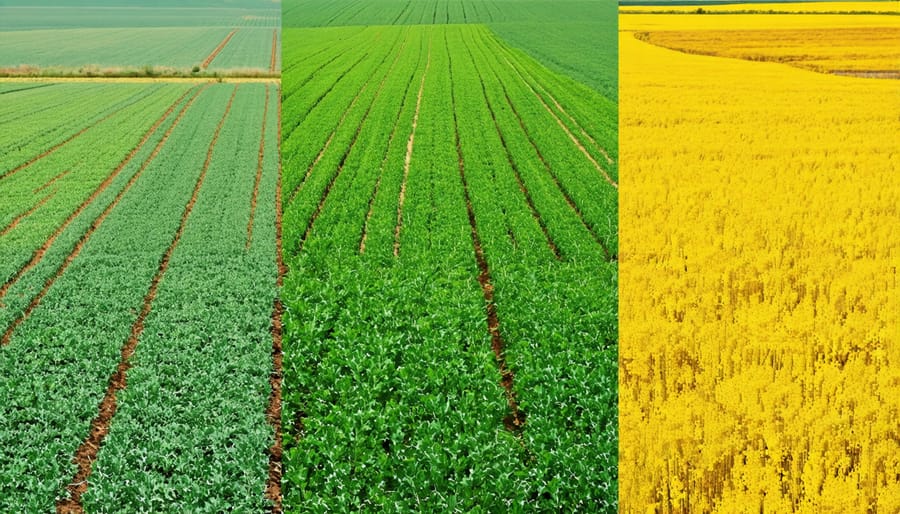
Land Conservation Strategies
While organic farming can present land-use challenges, Alberta farmers have developed effective strategies to optimize their land while maintaining organic certification. Crop rotation remains the cornerstone of sustainable land management, with many farmers implementing innovative four to six-year rotation cycles that include nitrogen-fixing legumes and cover crops.
Local success stories, like the Matthews Family Farm near Red Deer, demonstrate how integrating livestock into crop systems can enhance soil fertility while maximizing land use. Their rotational grazing approach allows cattle to naturally fertilize fields during fallow periods, reducing the need for additional organic inputs.
Buffer zones, while mandatory for organic certification, can be transformed into productive spaces. Many Alberta farmers plant native pollinator-friendly species in these areas, supporting both biodiversity and crop yields. Others use these zones for growing herbs or maintaining beneficial insect habitats.
Precision agriculture technology, compatible with organic standards, helps farmers optimize field layouts and identify areas best suited for different crops. GPS mapping and soil testing enable targeted interventions, reducing waste and improving overall land efficiency.
Collaborative land-sharing initiatives are gaining traction across the prairies, where organic farmers partner to rotate crops across multiple properties. This approach helps maintain soil health while maximizing productive acreage. The Southern Alberta Organic Cooperative, for instance, coordinates land-sharing among 15 farms, demonstrating how community-based solutions can address land-use challenges effectively.
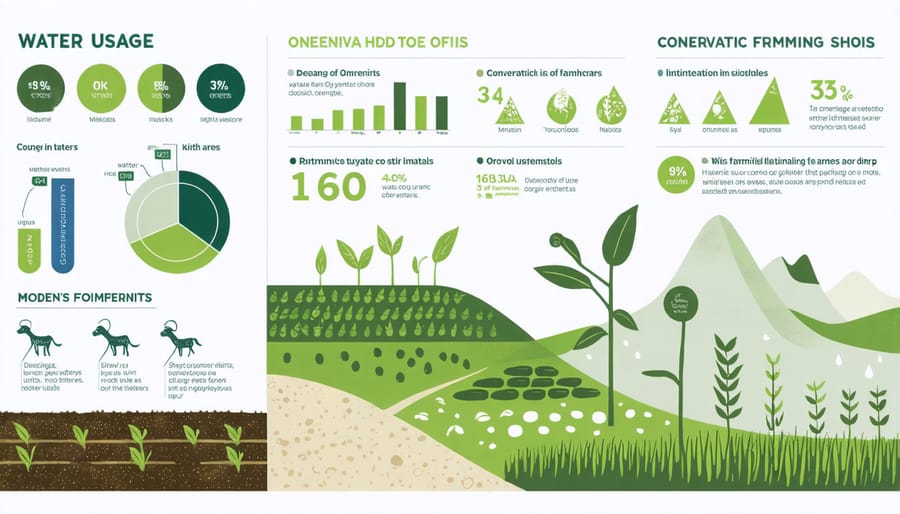
Water Management Under Organic Standards
Alberta’s Water Conservation Challenges
Alberta’s organic farmers face unique water management challenges due to the region’s semi-arid climate and varying precipitation patterns. Recent data from Alberta Agriculture shows that organic farms typically require 15-20% more irrigation water per hectare compared to conventional farms, primarily due to different soil management practices and weed control methods.
Local organic farmer Sarah Thompson from Lethbridge shares her experience: “We’ve implemented drip irrigation and soil moisture monitoring systems to maximize water efficiency. It’s an investment, but it’s helped us reduce water usage by 30% over the past three years.”
The Southern Alberta Irrigation District reports that organic farmers are increasingly adopting innovative water conservation techniques, including mulching, companion planting, and drought-resistant crop varieties. These methods help retain soil moisture and reduce overall water consumption while maintaining organic certification requirements.
Water-efficient organic farming practices are showing promising results. Research from the University of Alberta demonstrates that organic farms using conservation techniques can achieve water efficiency rates comparable to conventional operations. Key strategies include:
– Using cover crops to reduce soil evaporation
– Implementing precision irrigation systems
– Selecting drought-tolerant crop varieties
– Maintaining healthy soil organic matter levels
– Utilizing rainwater harvesting systems
These approaches not only conserve water but also support long-term soil health and biodiversity.
Innovative Compliance Solutions
Meeting organic certification requirements while maintaining efficient water use doesn’t have to be a trade-off. Many Alberta farmers have successfully implemented innovative solutions that satisfy both goals. For instance, precision drip irrigation systems, approved for organic farming, can reduce water consumption by up to 40% compared to traditional methods while ensuring compliance with organic standards.
Conservation tillage techniques, when combined with approved organic mulching materials like straw or grass clippings, help retain soil moisture while meeting certification requirements. Several farms in Southern Alberta have reported significant water savings using these methods, particularly during dry seasons.
Crop rotation planning that incorporates drought-resistant heritage varieties has proven effective for organic certification while naturally reducing irrigation needs. The University of Alberta’s Agricultural Research Station has documented success with ancient grain varieties that require 30% less water than conventional crops.
Modern soil moisture monitoring technologies, compatible with organic farming protocols, enable precise irrigation scheduling. These tools help farmers maintain optimal soil moisture levels while staying within organic guidelines. Some innovative farmers are also implementing gravity-fed irrigation systems using natural elevation changes, combining traditional wisdom with modern efficiency.
Local organic certification bodies now offer guidance on water-efficient practices that align with organic standards, making compliance more achievable while protecting our precious water resources.
Balancing Compliance and Environmental Stewardship
Best Practices from Alberta Farmers
Alberta’s organic farmers are leading the way in demonstrating how sustainable practices can benefit both the environment and farm productivity. Take the example of Sarah Johnston’s 400-hectare farm near Red Deer, where innovative crop rotation and natural pest management have shown remarkable results. Johnston’s implementation of cover crops has reduced soil erosion by 40% while improving soil organic matter content by 2.5% over five years.
The environmental benefits of organic farming are particularly evident at the Miller Family Farm near Lethbridge, where their integrated livestock-crop system has eliminated the need for synthetic fertilizers. By rotating cattle through their fields, they’ve enhanced soil fertility naturally while reducing water consumption by 30% compared to conventional methods.
In the Peace River region, Kevin Zhang’s innovative approach to weed management using mechanical cultivation and strategic crop planning has proven that organic farming can be both environmentally sustainable and economically viable. His farm has documented a 45% increase in beneficial insect populations while maintaining competitive yields.
These success stories share common elements: detailed planning, careful observation of natural systems, and patience during the transition period. Most importantly, these farmers emphasize the importance of building robust soil biology before expecting optimal yields. They’ve found that investing in soil health during the first three years of organic transition pays dividends in reduced input costs and improved crop resilience in subsequent seasons.
Local organic certification bodies report that farms following these best practices typically achieve certification within three years while maintaining or improving their soil quality metrics.
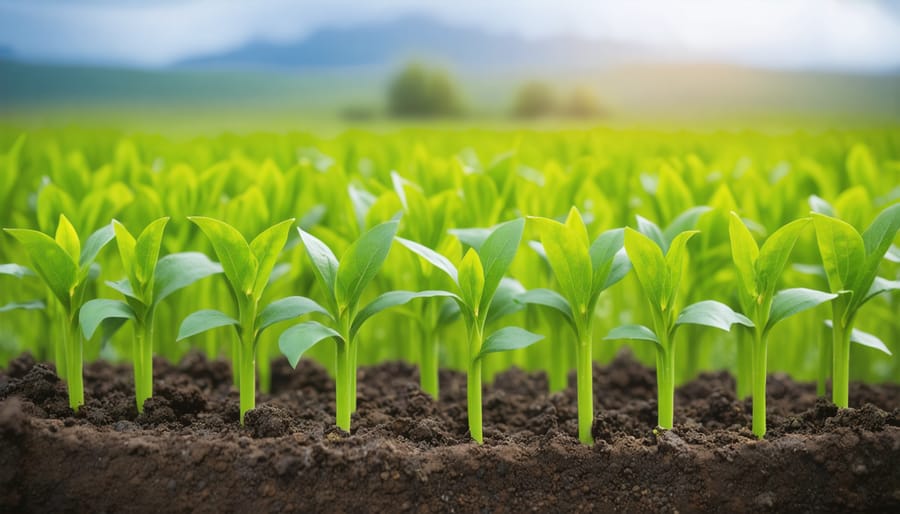
Future-Focused Solutions
As we look to the future of organic farming in Alberta, innovative solutions are emerging that address both environmental concerns and productivity challenges. Modern sustainable farming practices are combining traditional organic methods with cutting-edge technology to optimize resource use and reduce environmental impact.
Precision organic farming technologies, such as GPS-guided equipment and soil sensors, are helping farmers apply organic inputs more efficiently while minimizing soil disturbance. These tools allow for targeted application of approved organic fertilizers and more precise water management, reducing waste and environmental impact.
Cover cropping strategies are evolving, with new research highlighting optimal plant combinations for Alberta’s climate. Multi-species cover crop systems are showing promising results in building soil health while providing natural pest control and reducing the need for intervention.
Conservation agriculture techniques are being integrated into organic systems through methods like minimal tillage and permanent bed systems. These approaches help maintain soil structure while managing weeds effectively, addressing one of organic farming’s biggest environmental challenges.
Innovative crop rotation designs, specifically adapted for our prairie conditions, are helping farmers maintain productivity while building soil organic matter. These rotations incorporate drought-resistant varieties and nitrogen-fixing crops suited to our regional climate.
Local agricultural extension services are now offering specialized training in these emerging techniques, helping Alberta farmers transition to more efficient organic methods. Farmer-led research networks are also playing a crucial role in testing and adapting these innovations for our unique growing conditions.
By embracing these solutions, organic farmers can maintain certification requirements while enhancing their environmental stewardship and farm viability.
While organic farming presents both challenges and opportunities for environmental stewardship, our analysis reveals that its impact largely depends on implementation practices and local conditions. For Canadian farmers, particularly in Alberta, the key to successful organic farming lies in adopting a balanced approach that combines traditional organic principles with modern sustainable innovations.
The evidence suggests that organic practices can significantly benefit soil health, biodiversity, and water conservation when properly managed. However, these benefits must be weighed against potential challenges such as lower yields and increased land use. To maximize environmental benefits while maintaining viable operations, we recommend several practical steps for Canadian organic farmers:
First, implement integrated pest management strategies using beneficial insects and crop rotation to reduce dependency on organic pesticides. Second, adopt precision farming techniques to optimize resource use, even within organic constraints. Third, participate in local farmer networks to share knowledge and resources, particularly during transition periods.
For those considering organic certification, start with a thorough soil analysis and develop a detailed transition plan. Consider implementing organic practices on a portion of your land first to gain experience and minimize risks. Take advantage of provincial support programs and connect with experienced organic farmers in your region.
Remember that organic farming isn’t just about following certification rules – it’s about building resilient agricultural systems that benefit both the environment and farm viability. By focusing on soil health, biodiversity, and efficient resource management, Canadian organic farmers can contribute positively to environmental conservation while maintaining productive operations.

